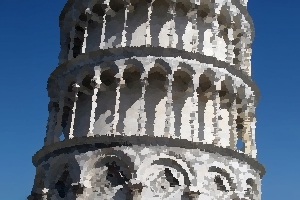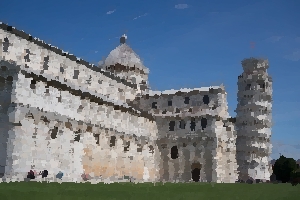When did it start leaning?
Construction on the Pisa Tower began in August of 1173. At this time in history, Pisa (and Italy in general) was going through a military success period, which means that money was flowing readily. During this first building period, the foundation was laid, and the first floor was constructed, according to the plans of the original architect, Bonanno Pisano. In 1178, construction stopped. Although the tower was nowhere near finished, the War with Firenze broke up, causing the men working on the building to enlist in the army and leave the construction site. This was the year the lean first became noticeable.
A slightly curved tower as well
 A closer view of the Tower of Pisa's architecture. [Report image]
A closer view of the Tower of Pisa's architecture. [Report image]Within the next ten years, the first three floors were added, but war once again got in the way of the building of this beautiful tower.
Over 100 years late, designer Giovanni di Simone began construction once again, adding three more layers to this leaning layer cake, and by 1284, the tower was considered finished at long last. Simone attempted to correct the leaning problem by building one side of the wall higher than the other, and for this reason, the building is, in fact, curved.
Carefully watched by scientists
The tower continues to sink every year, under the watchful eyes of scientists who ensure that the structure is still safe. Although the ground is still swampy below the tower, it has settled greatly from its first days of construction so that it only now sinks about one or two millimeters per year. It is quite safe for tourists, and it would be a shame to visit Italy without stopping by this grand architectural masterpiece.
Mussolini's failed attempt to put it back straight
Over the centuries, people have done studies on the tower, and some have even attempted to stop its lean. As a rule, Benito Mussolini ordered that the tower be fixed and worked attempted to achieve this by pouring concrete into the base foundation. However, this did not cause the building to tilt vertically, as Mussolini had hoped. Instead, it simply made the tower heavier, causing it to begin to sink even farther into the swampy soil below.
Anecdotal stories
Several events allegedly happened at the Pisa Tower, although some were never officially recorded, so it is impossible to know if they actually took place. For example, Galileo was rumored to have dropped two cannonballs off of the tower on different sides to measure their mass and speed. One tale that is confirmed is the use of the building as a Nazi observation tower. The United States' decision not to strike ultimately saved the tower, while it would have otherwise been defaced and possibly collapsed.
Maintaining its lean as a tourist attraction
 The Pisa Tower behind the Cathedral in Tuscany, Italy. [Report image]
The Pisa Tower behind the Cathedral in Tuscany, Italy. [Report image]In the mid-1960s, the town of Pisa and Italy began exploring options to keep the tower from tumbling over. However, it was imperative to historians and government officials to maintain the tower's signature tilt, which has created its fame over the years. Without the inclination, tourism in Pisa would drop significantly. In 1990, after decades of studying the leaning landmark, a team of engineers, mathematicians, and historians decided to close the tower to the public for several years to work on stabilizing the lean. The building was actually closed for well over a decade, and the people living in the surrounding areas were vacated. They also used cables to secure the tower at the third-floor level, and they removed some of the weight by taking the bells out.In December 2001, the tower was reopened and declared safe and stable for at least 300 years. During the restoration project, the team considered various options and decided to decrease the lean by removing soil from the elevated side. They discovered that much of the lean was due to the actual stonework and building materials used to build the tower originally.